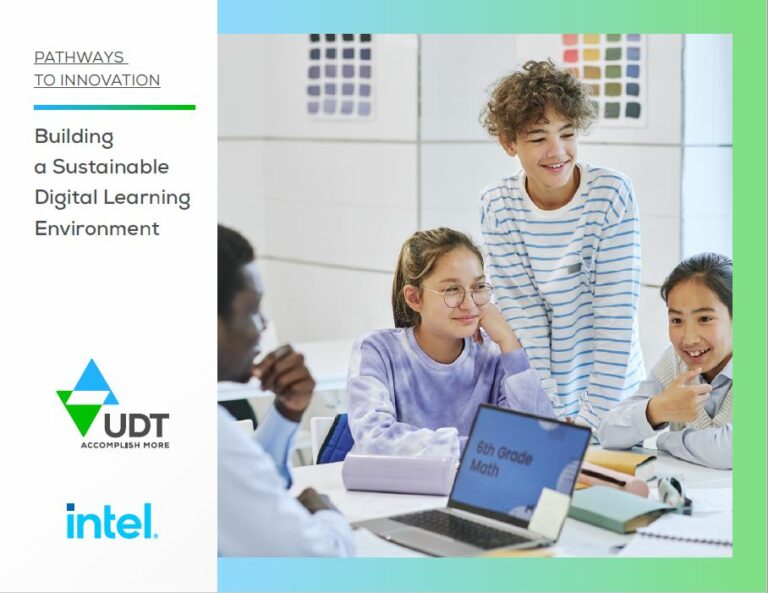As a school leader, you understand the pivotal role that 1:1 device programs play in providing a diverse and enriching educational experience, both within the classroom and in remote settings. Recognizing the significance of this program for student achievement and future readiness, you also grapple with the financial and resource demands placed on your district, particularly amid budget constraints and competing priorities. As a result, it can be difficult to ensure your district has secured the appropriate amount of money from all available funding sources for each school year.
Unlock your pathway to innovation with our guide.
Building 1:1 digital learning environments is a complex journey. To help you achieve the best outcomes, UDT & Intel have collaborated to gather key insights from seasoned CIOs, CTOs, educational leaders, and educators. Here’s what you’ll gain:
- Personalized workbook to help you identify target areas to improve your 1:1 programs
- A student-centered, decision-making Framework covering 6 key focus areas
- A self-assessment to guide your journey
- Details on how to create your custom action plan
- And more!
Download your free copy now to start developing your personalized action plan.
The Rise of 1:1 Device Programs to Fuel Digital Learning
A 2021 survey of educators found that student access to school-issued devices jumped from under 50 to 84% during the pandemic era. For middle and high school students, the jump was from two-thirds to 90%. With the rise of 1:1 device programs, it’s important for educators to read up on the latest education technology (EdTech) trends and apps that can enhance the learning experience. This is especially crucial for English language learners, who can greatly benefit from personalized learning tools.
The Importance of Sustainable Funding
Securing sustainable funding is a linchpin for the functionality, success, and longevity of 1:1 device initiatives in school districts. Often, this involves directing resources towards capital expenses (CapEx); however, it’s arguably more crucial to invest in long-term operational expenses (OpEx). This approach enables you and your team to make decisions based on future needs. Moreover, investing in cost-effective solutions can help stretch your budget further. This includes exploring different pricing models for device procurement and considering open-source or free educational apps for K12 education.
Navigating the Funding Landscape in K-12 Schools
As school districts face the evolving landscape of both information technology and educational technology, the demand for equitable access to devices and digital resources remains a top priority. In the wake of unprecedented challenges (like the pandemic) understanding the dynamic funding environment is crucial for making informed decisions.
In addition, ensuring connectivity for all students is a key aspect of 1:1 device programs. This means not only providing access to the use of technology but also addressing the digital divide by ensuring that all students have reliable Internet access.
CoSN’s Blaschke Report on Navigating Student Device 1:1 Sustainability found that “Funding devices through OpEx is more practical and aligns better with the recurring nature of technology expenses, offering a pay-as-you-go model that minimizes financial risk or waste for school districts.”
Maximizing the Value of K12 Tech Investments
The intricacies of funding 1:1 device programs extend beyond a one-time expenditure; it involves an ongoing and intricate process marked by various factors and challenges. These include the following considerations:
- The type and configuration of devices,
- Network and cloud infrastructure,
- Security policies and maintenance systems,
- User training and support programs,
- Device replacement and upgrade cycles,
- Compliance with relevant laws and regulations,
- Assessment and enhancement of program outcomes.
Navigating funding challenges demands thinking of creative solutions, collaborating with other districts, embracing innovative technologies and practices, and engaging with stakeholders. It may be necessary to explore various funding avenues, including grants, bonds, and private-public partnerships to ensure availability of all necessary technology resources.
The Impact of a Strong OpEx Approach: Crafting Your Technology Plan
By strategically implementing a strong OpEx approach, you can ensure the success, equity, and impact of your 1:1 device program for all students and teachers, while securing a predictable investment environment for sustained and effective funding. CoSN found that “through OpEx funding, schools can spread costs over time, avoiding large upfront investments that may be burdensome for budgets. This approach offers greater flexibility and enables schools to regularly refresh and update devices to keep pace with technological advancements.”
Key Considerations for Public Schools
Consider the following funding-related questions:
- How will you approach funding for 1:1 initiatives beyond reliance on specific grants or expiring pandemic-related funds?
- What are the challenges and opportunities that arise from the need for sustained financial support for 1:1 device initiatives?
- How might you establish a flexible funding model that adapts to technological advancements and student needs?
By addressing these questions, you can navigate the complexities of funding 1:1 device programs and ensure their success and sustainability in your school district.
Get the Funding Your School District Deserves!
Navigating the funding landscape for 1:1 device programs is a complex but crucial task. It requires a deep understanding of both the educational and financial aspects of these initiatives. By staying informed about the latest EdTech trends, exploring cost-effective solutions, and ensuring connectivity for all students, school leaders can make informed, impactful decisions.
With decades of experience supporting a majority of the 10 largest school districts in the US, UDT is a trusted partner for educational institutions that need to optimize limited funding to support their 1:1 device initiatives. UDT can provide customized solutions, expert guidance, and ongoing support to help you achieve your goals while protecting and empowering your students and staff.
If you are interested in learning more about how UDT can help your school district, please contact us to schedule a consultation.

